If you were expecting some kind of sun sign nonsense, forget it. This is real astrology. See the section above. Please note: this forecast is expressed in terms of Universal Time (UT). Current UT date and time appear at the top of this page. (To update display, use your browser's reload/refresh button.)
If Jupiter and Saturn meet,
What a crop of mummy wheat!
W. B. Yeats, Supernatural Songs (1935)
Planetary alignments - termed conjunctions and oppositions in astrological tradition - are preeminent among celestial configurations. When they form in the heavens, such alignments signify an unusual confluence of cosmic power and meaning - literally a warp or ripple in the local fabric of space/time. The year 2000 features alignments the likes of which have not been seen for generations. This means that the true last year of the millennium - the 21st Century doesn't start until the year 2001 - will be a roller-coaster ride to remember. If you think you saw millennial madness in 1999, wait 'til you see what 2000 has in store! It won't be an Apocalypse, as the 5/5/2000 doomsayers proclaim. But it will be a year for the history books.
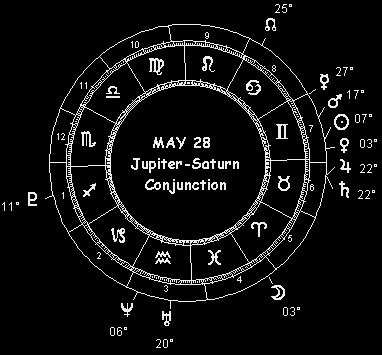 Foremost among the alignments ahead is the conjunction of Jupiter and Saturn, known from ancient times as the Great Chronocator. The astrologers of old so named it because they had come to understand this conjunction as signaling great watershed moments of history - social, political and cultural turning points. Hundreds of years before the fact, Persian astrologers used just such an alignment to predict the birth of a "King of the Jews", to coincide with a Jupiter-Saturn conjunction in Pisces (from ancient times considered symbolic of the Jewish nation). As it turned out, there was a triple appearance of the Great Chronocrator in that sign in the year 7 BCE (aka BC), the period when most historians believe Jesus of Nazareth was born. This year's conjunction won't be a 'three-peat': it happens only once as seen from our home planet, on May 28. But these two giants of our solar system remain just five degrees apart all the way from April 12 through July 15 as seen from Earth. From a heliocentric - i.e. Sun-centered - perspective, the exact conjunction occurs on June 22 and remains within five degrees for six months, from March 21 to September 24. (Need help with the astrological symbols in the chart? See my Astroglyphs guide!)
Foremost among the alignments ahead is the conjunction of Jupiter and Saturn, known from ancient times as the Great Chronocator. The astrologers of old so named it because they had come to understand this conjunction as signaling great watershed moments of history - social, political and cultural turning points. Hundreds of years before the fact, Persian astrologers used just such an alignment to predict the birth of a "King of the Jews", to coincide with a Jupiter-Saturn conjunction in Pisces (from ancient times considered symbolic of the Jewish nation). As it turned out, there was a triple appearance of the Great Chronocrator in that sign in the year 7 BCE (aka BC), the period when most historians believe Jesus of Nazareth was born. This year's conjunction won't be a 'three-peat': it happens only once as seen from our home planet, on May 28. But these two giants of our solar system remain just five degrees apart all the way from April 12 through July 15 as seen from Earth. From a heliocentric - i.e. Sun-centered - perspective, the exact conjunction occurs on June 22 and remains within five degrees for six months, from March 21 to September 24. (Need help with the astrological symbols in the chart? See my Astroglyphs guide!)
This time around the alignment is in Taurus, for the first time since the 1940-41 triple conjunction in that sign. This means interest rate hikes and commodity price increases (especially in precious metals, agricultural products and equipment, and all kinds of essential staples). It also points to a period of economic instability practically worldwide, as over-valued companies and currencies get put through the wringer. This won't happen all at once, but will be spread here and there throughout the year. And it doesn't mean an economic collapse of the 1929 variety - that's still some years away. Rather, this will be a period of adjustment followed by the resumption of a boom that takes the world economy higher still. Investors who head for quality will do nicely, even as speculators who pursue the bubble de jour stocks take a bath. (Look for companies that build equipment and infrastructure, particularly in the communications field and the financial sector. But be aware that the Saturn-Uranus square will play havoc in both these areas for a time - more about that later.) Remember: the Great Chronocrator sets up a 20-year cycle of expansion and adjustment - economically, culturally, politically. This won't happen all at once, and it won't be over soon.
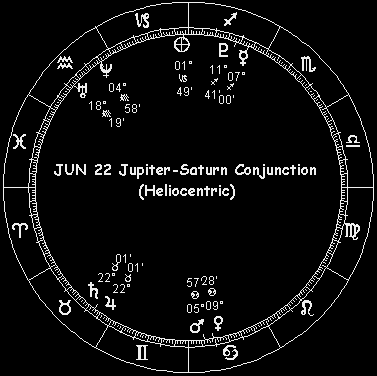 William Butler Yeats had a prophetic view of a great many things, including the Jupiter-Saturn conjunction. His reference to "mummy wheat" in connection with the Great Chronocrator hearkens back to the ancient Egyptian custom of entombing wheat kernels with mummies, as a provision for the afterlife. To get a lot of mummy wheat, you need a lot of mummies. And to get a lot of mummies, you need a lot of . . . well, you know. (We say good-bye to the high priest, and watch stupefied as the bridge-builder fails to complete his appointed crossing.) Yeats' Supernatural Songs was published just a few years before the last Jupiter-Saturn conjunction in Taurus, which formed in the heavens as World War II was beginning in earnest. I don't see a World War waiting in the wings this time around, but you can bet that 2000 will present us with plenty of mummy fodder nonetheless. (Incidentally, Yeats was more than a casual student of astrology. In a 1921 letter to his sister Lily, Yeats remarked that he found his son Michael's "horoscope . . . quite compatible with a diplomatic career." As it turned out, Michael Yeats grew up to serve as Chairman of the Irish Senate and as a member of the European Parliament.)
William Butler Yeats had a prophetic view of a great many things, including the Jupiter-Saturn conjunction. His reference to "mummy wheat" in connection with the Great Chronocrator hearkens back to the ancient Egyptian custom of entombing wheat kernels with mummies, as a provision for the afterlife. To get a lot of mummy wheat, you need a lot of mummies. And to get a lot of mummies, you need a lot of . . . well, you know. (We say good-bye to the high priest, and watch stupefied as the bridge-builder fails to complete his appointed crossing.) Yeats' Supernatural Songs was published just a few years before the last Jupiter-Saturn conjunction in Taurus, which formed in the heavens as World War II was beginning in earnest. I don't see a World War waiting in the wings this time around, but you can bet that 2000 will present us with plenty of mummy fodder nonetheless. (Incidentally, Yeats was more than a casual student of astrology. In a 1921 letter to his sister Lily, Yeats remarked that he found his son Michael's "horoscope . . . quite compatible with a diplomatic career." As it turned out, Michael Yeats grew up to serve as Chairman of the Irish Senate and as a member of the European Parliament.)
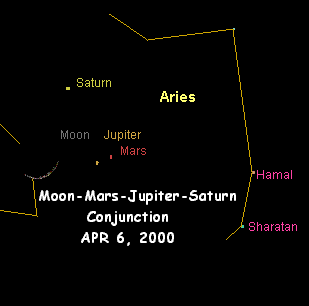 Although it appears only once this time around, this year's Jupiter-Saturn conjunction is a triple in its own right. As Mars enters the sign Taurus - the constellation Aries, see my article if you don't know the difference - late in March, the Red Planet starts moving in on a triple conjunction with Jupiter and Saturn. The trio will be aligned within not more than five degrees from one another April 7-23. And if you look to the western horizon in the evening twilight on April 6, when Mars aligns with Jupiter, you'll see a real wonder as the Moon joins these three planets all in a tight celestial knot. Triple conjunctions of Mars, Jupiter and Saturn are exceedingly rare. This will be only the third such triple conjunction of the naked eye superior planets this century. The last was in November 1921 (Libra), and the one before that took place in December 1901 (Capricorn). There won't be another until the August 2040 triple alignment in Libra, so don't miss it this time around.
Although it appears only once this time around, this year's Jupiter-Saturn conjunction is a triple in its own right. As Mars enters the sign Taurus - the constellation Aries, see my article if you don't know the difference - late in March, the Red Planet starts moving in on a triple conjunction with Jupiter and Saturn. The trio will be aligned within not more than five degrees from one another April 7-23. And if you look to the western horizon in the evening twilight on April 6, when Mars aligns with Jupiter, you'll see a real wonder as the Moon joins these three planets all in a tight celestial knot. Triple conjunctions of Mars, Jupiter and Saturn are exceedingly rare. This will be only the third such triple conjunction of the naked eye superior planets this century. The last was in November 1921 (Libra), and the one before that took place in December 1901 (Capricorn). There won't be another until the August 2040 triple alignment in Libra, so don't miss it this time around.
Among other things, this particular triple conjunction points to a resurgence of collectivism and militarism; also a cycle high in air travel disasters (from about March 23 though May 3). More ethnic cleansing and military conflict is on tap off and on all year, as demagogues seek to blame minorities and foreign powers for all kinds of ills, in order to whip up the kind of mob frenzy that leads to blind obedience. Not that it takes much whipping-up: with Mars crossing over its own north node on March 25, people are pretty much on a hair trigger anyway. Watch for a resurgent socialist movement - in reality, fascism with an ideological cover - in the old Soviet bloc. This is a year of hysteria, which can always be exploited by the demagogues of the world.
For all life longs for the Last Day
And there's no man but cocks his ear
To know when Michael's trumpet cries
That flesh and bone may disappear,
And souls as if they were but sighs,
And there be nothing but God left.
W. B. Yeats, Running to Paradise (1913)
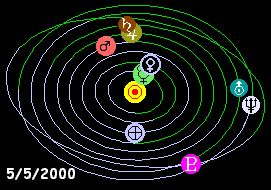 Speaking of hysteria, the 5-5-2000 crowd have followed a Pied Piper prediction for years; namely that Earth's poles will flip and most of humanity will perish in the process, when "for the first time in 6,000 years all the planets of our solar system will be arrayed in practically a straight line in space." Bullshit! As I pointed out years ago when Richard Noone's book started this particular piece of millennial madness, the May 5, 2000 alignment isn't especially tight in the first place. An even tighter alignment occurred in 1962, and we all remember the world ending then. Yes, 2000 will have more than its share of natural disasters, but a pole-flip won't be among them. (Huge chunks of polar ice breaking away, yes - but our home planet is not going off its axis.) You can pretty well count on Saturn's transit through Taurus ushering in a period of heavy earthquake activity, particularly when the Great Chronocrator occurs in this sign. Some of this Century's worst earthquakes and most notable volcanic eruptions followed the Jupiter-Saturn conjunction in Taurus of 1940-41. The current Saturn transit through Taurus began in 1998, and has been accompanied by some of the worst earthquakes of the 90s - including the terrible Turkish quake of 1999. Expect more of the same this year, most notably in January-February, April-May, July and December.
Speaking of hysteria, the 5-5-2000 crowd have followed a Pied Piper prediction for years; namely that Earth's poles will flip and most of humanity will perish in the process, when "for the first time in 6,000 years all the planets of our solar system will be arrayed in practically a straight line in space." Bullshit! As I pointed out years ago when Richard Noone's book started this particular piece of millennial madness, the May 5, 2000 alignment isn't especially tight in the first place. An even tighter alignment occurred in 1962, and we all remember the world ending then. Yes, 2000 will have more than its share of natural disasters, but a pole-flip won't be among them. (Huge chunks of polar ice breaking away, yes - but our home planet is not going off its axis.) You can pretty well count on Saturn's transit through Taurus ushering in a period of heavy earthquake activity, particularly when the Great Chronocrator occurs in this sign. Some of this Century's worst earthquakes and most notable volcanic eruptions followed the Jupiter-Saturn conjunction in Taurus of 1940-41. The current Saturn transit through Taurus began in 1998, and has been accompanied by some of the worst earthquakes of the 90s - including the terrible Turkish quake of 1999. Expect more of the same this year, most notably in January-February, April-May, July and December.
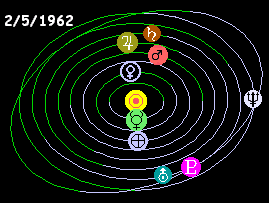 The eclipses and SuperMoons of 2000 rank as prime suspects among indicators regarding the timing of the year's worst storms, floods and seismic activity. (A SuperMoon, in case you don't know, is a perigee-syzygy: a new or full moon that occurs with the Moon at or very near its closest approach to Earth.) Major geophysical shock windows extend three days either side of the year's only non-eclipse SuperMoon (June 2) as well as the January 21 lunar eclipse (also a SuperMoon) and the July 16 lunar eclipse. The risk period extends seven days either side of the year 2000 solar eclipses: February 5, July 1 (also a SuperMoon), July 31 (another SuperMoon), and December 25. Strong storms, flooding, extreme coastal tides and moderate to severe seismic activity (Richter 5 or greater earthquakes and volcanic eruptions) are on tap during these risk windows - not to mention a penchant for conflict, confrontation and general lunacy at the human level. I have used such alignments since 1979 - when I predicted Hurricane David's strike on Savannah in a national magazine published six weeks before the fact using a SuperMoon eclipse to guide me - and they have timed some of the major natural upheavals to strike the world in that time. Because these alignments are planetary in scale, the geophysical phenomena associated with them can strike virtually anywhere in the world. But clues to areas of special risk can often be discerned from studying astro-locality maps showing where the planets are most directly focused onto Earth: where they rise, set, or are directly overhead or below at the moment of the event.
The eclipses and SuperMoons of 2000 rank as prime suspects among indicators regarding the timing of the year's worst storms, floods and seismic activity. (A SuperMoon, in case you don't know, is a perigee-syzygy: a new or full moon that occurs with the Moon at or very near its closest approach to Earth.) Major geophysical shock windows extend three days either side of the year's only non-eclipse SuperMoon (June 2) as well as the January 21 lunar eclipse (also a SuperMoon) and the July 16 lunar eclipse. The risk period extends seven days either side of the year 2000 solar eclipses: February 5, July 1 (also a SuperMoon), July 31 (another SuperMoon), and December 25. Strong storms, flooding, extreme coastal tides and moderate to severe seismic activity (Richter 5 or greater earthquakes and volcanic eruptions) are on tap during these risk windows - not to mention a penchant for conflict, confrontation and general lunacy at the human level. I have used such alignments since 1979 - when I predicted Hurricane David's strike on Savannah in a national magazine published six weeks before the fact using a SuperMoon eclipse to guide me - and they have timed some of the major natural upheavals to strike the world in that time. Because these alignments are planetary in scale, the geophysical phenomena associated with them can strike virtually anywhere in the world. But clues to areas of special risk can often be discerned from studying astro-locality maps showing where the planets are most directly focused onto Earth: where they rise, set, or are directly overhead or below at the moment of the event.
The geophysical shock windows for 2000 start off with the SuperMoon total lunar eclipse of January 21 (in effect January 18-24). This one appears to be especially strong along a northwesterly arc that extends from the southwest tip of Africa into the Middle East, curving from there across Russia and over to the Aleutians, curving from there down to Hawaii; as well as on a north-south line extending from the west coast of Australia straight up into eastern China and Mongolia, and last but not least along a north-south line running from eastern Canada down through the eastern Caribbean into South America. (This latter zone lies at the heart of the region where the entire eclipse will be visible.)
In effect January 29 - February 12, the February 5 partial solar eclipse focuses on east Africa and the western British Isles, the US Midwest and eastern Canada, New Zealand and the far eastern stretches of Russia; and along a northwesterly arc from west India through Pakistan, across Russia over to Scandinavia. Watch for this one to wreak havoc with power and communications infrastructure. But don't bother looking for this eclipse, unless you plan on being in Antarctica at the time.
The June 2 SuperMoon, in effect May 30 - June 5, zeroes in on a north-south zone that stretches from Great Britain across the Channel to western Europe, southward down through west Africa. Another risk zone curves in a northwesterly direction from the southern tip of South America, up to Mexico and through the western US, and then out across the Bering Strait. The eastern end of this zone stretches northeastward from the Indian Ocean across Indochina and China, joining up with its western counterpart in the Bering Strait. The juncture of these two zones is itself crossed by a north-south risk zone that runs from New Zealand up to Kamchatka. This is the first in a string of Sun-Moon alignments with a strong Mars component: crime, violence, aggression and confrontation.
The July 1 partial solar eclipse - a SuperMoon, as well as the last New Anteblue Moon of the 20th Century - is in effect from June 24 through July 8. (A New AnteBlue Moon is the first of a pair of two new moons to occur in the same month of the Gregorian calendar.) The India-Pakistan border lies along a north-south risk zone during this period - a zone mirrored half a world away along the Pacific coast of Mexico and northward into the western US and Canada. Also in the bulls eye this time around is a sweeping arc that runs across northwestern Africa into Europe, sweeping from there across northern Russia and then out through the Korean Peninsula and Japan down to New Zealand. Southern Argentina and Chile, where the eclipse is visible, may also be at risk of seismic and meteorological events during the June 24 - July 8 period. Mars is central to this eclipse: aggression abounds.
The total lunar eclipse of July 16 - in effect July 13-19 - is strong along a north-south line from the east coast of Brazil through eastern Greenland. This zone is mirrored by another north-south swath from eastern Australia through Papua New Guinea, northward from there through the Sea of Okhotsk between Japan and Kamchatka: these are the regions where the entire eclipse will be visible. Alaska, India, eastern China, Mongolia and the far eastern stretches of Russia round out the risk sectors during this lunar eclipse. Mars being prominent at this eclipse, I'm reminded of the advice given by one of my Sifus to the student who inquired about getting full-coverage headgear for sparring, in hopes of preventing another broken nose: "Well, duck!"
The partial solar eclipse of July 31 - with a risk window extending from the 24th through August 7 - is both a SuperMoon and the last New Blue Moon of the 20th Century. (A The New Blue Moon is the second of a pair of two new moons to occur in the same month of the Gregorian calendar.) The western US lies in the target zone for this one, as well as most of Europe, East Africa and the Middle East. (The eclipse will be visible from northern Scandinavia, eastern Russia, Alaska, western Canada and the northwestern US.) A pair of north-south swatches round out the risk sectors during this SuperMoon eclipse: one runs from Greenland down through eastern South America, and the other from Japan down through eastern Australia. Although still involved this time around, Mars isn't so central as it was in the other two July eclipses: while still high as Sun and Moon align at the end of July, tension and conflict should ease up once we get this one behind us.
Closing out the year is the December 25 partial solar eclipse, staking its claim to a storm and seismic risk window that extends from the 18th all the way to January 1, 2001. Severe winter storms in Canada and the eastern US look like part of this one, along with freaky weather and an earthquake watch for New Zealand, the Indochina peninsula, and the central regions of China and Mongolia. This one will be visible throughout most of North and Central America.
The aforementioned eclipses and SuperMoons represent the bulk of the storm and seismic risk windows for the year 2000. There are others, although they tend to be shorter in duration. Even ordinary garden-variety new and full moons up the ante for disturbances of this sort. So do lunar declination extremes, when the Moon attains its greatest distance above or below the celestial equator. Likewise ordinary perigees - again, the Moon's closest approach to Earth. Although these risk windows are nowhere near as wide as those associated with an eclipse or a SuperMoon - they tend to be effective only for a little more than a day either side of the exact event - they're still too useful to ignore. But they're too numerous to detail here. If you're interested, see my online lunar perigee and declination cycle tables for the year 2000.
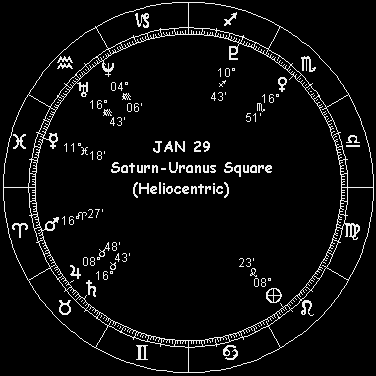 I've only hit the highlights here, but can't close without mentioning a couple more of the year's most significant planetary configurations. One is the Saturn-Uranus square, the Y2K aspect. That's right, as I indicated in last year's forecast, it won't disappear when 1999 is history. As I've already pointed out, these two planets haven't been more than five degrees from an exact geocentric square since the end of May '99, and won't get outside that range until January 2000 - only to regenerate in March on its way to becoming exact on May 13. And the heliocentric square - exact on January 29, 2000 - has been within five degrees since mid-July '99, remaining so until mid-August 2000. If you read last year's forecast, you know what to expect: breakdowns in high-technology infrastructure (principally computers and communication) as well as criminal assaults on that infrastructure. The latter will be of two types: for financial gain, as well as to wreak havoc either for sheer vandalistic gratification or to make a political point. Computer viruses and hacker attacks are bound to be a part of this, but some of the chaos will stem from inherently poor system design. (Short-sightedness and the law of unintended consequences will always exact their toll.)
I've only hit the highlights here, but can't close without mentioning a couple more of the year's most significant planetary configurations. One is the Saturn-Uranus square, the Y2K aspect. That's right, as I indicated in last year's forecast, it won't disappear when 1999 is history. As I've already pointed out, these two planets haven't been more than five degrees from an exact geocentric square since the end of May '99, and won't get outside that range until January 2000 - only to regenerate in March on its way to becoming exact on May 13. And the heliocentric square - exact on January 29, 2000 - has been within five degrees since mid-July '99, remaining so until mid-August 2000. If you read last year's forecast, you know what to expect: breakdowns in high-technology infrastructure (principally computers and communication) as well as criminal assaults on that infrastructure. The latter will be of two types: for financial gain, as well as to wreak havoc either for sheer vandalistic gratification or to make a political point. Computer viruses and hacker attacks are bound to be a part of this, but some of the chaos will stem from inherently poor system design. (Short-sightedness and the law of unintended consequences will always exact their toll.)
And then there's the Jupiter-Pluto opposition, which forms the first two phases of its triple-play series late in the year (September 4 and October 13) and remains within a five degree orb all the way from late July to mid-November. US-Cuban relations appear to be ripe for reaching a turning point during this alignment, and paper assets for a sharp devaluation. Not a good time to be in highly speculative, liquidity-driven stocks from companies that can't turn a profit, as the money supply undergoes some peculiar contortions. (No, that doesn't include all the Internet high-fliers - but it applies to a lot of them in this, the year of a huge shake-up on the World Wide Web.) Not a good time for Israel . . . China waxes strong militarily and politically . . . a turning point in the Islamic world, where a concentration of geopolitical power is growing amidst the most significant leadership changes in years.
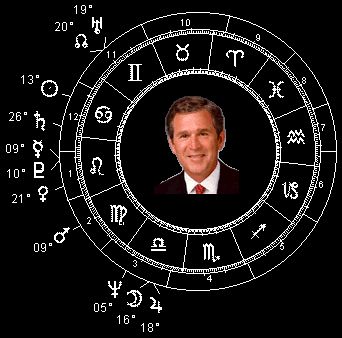 In closing, and in recognition of a lot of interest surrounding the upcoming November 7 US elections, I have to say there's a whole raft of problems involved in analyzing what lies ahead in that respect. John McCain's birth time hasn't been made public as of this writing, nor his exact place of birth (somewhere in the Panama Canal Zone). From what I can see of his chart, it may be the best of the lot in terms of being Presidential come November 7. I do have what appear to be reliable timed data for George W. Bush: 7:26 AM EDT on July 6, 1946 in New Haven CT. (Source: astrologer Kim Castilla cites Bush's birth certificate.) At present, all I can say is that George W. Bush's chart has better transits than Al Gore's at election time. Even Bill Bradley's chart looks better than Gore's for November 7. But until all this comes down to the final nominated candidates - hopefully with full and well-documented birth data - I really can't be more specific. And besides, Tecumseh's Curse could still toss a wild card onto the table - and Al Gore into the White House before the inauguration.
In closing, and in recognition of a lot of interest surrounding the upcoming November 7 US elections, I have to say there's a whole raft of problems involved in analyzing what lies ahead in that respect. John McCain's birth time hasn't been made public as of this writing, nor his exact place of birth (somewhere in the Panama Canal Zone). From what I can see of his chart, it may be the best of the lot in terms of being Presidential come November 7. I do have what appear to be reliable timed data for George W. Bush: 7:26 AM EDT on July 6, 1946 in New Haven CT. (Source: astrologer Kim Castilla cites Bush's birth certificate.) At present, all I can say is that George W. Bush's chart has better transits than Al Gore's at election time. Even Bill Bradley's chart looks better than Gore's for November 7. But until all this comes down to the final nominated candidates - hopefully with full and well-documented birth data - I really can't be more specific. And besides, Tecumseh's Curse could still toss a wild card onto the table - and Al Gore into the White House before the inauguration.
ACKNOWLEDGMENTS All astrological charts and astro-locality maps were calculated and produced using Matrix Software's WinStar. (See the Astrology Software section of Astropro's NetSelect Directory.) Sky map for the April 6 Moon-Mars-Jupiter-Saturn alignment was calculated and produced using Maris Multimedia's RedShift2. Solar system maps for May 5, 2000 and February 5, 1962 were calculated and produced using John Walker's Home Planet. (Details on and links to both programs are available under the Software heading in the Astronomy section of Astropro's NetSelect Directory.)